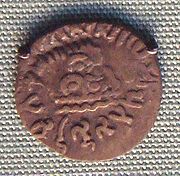
Overstrike (numismatics)
Encyclopedia

Numismatics
Numismatics is the study or collection of currency, including coins, tokens, paper money, and related objects. While numismatists are often characterized as students or collectors of coins, the discipline also includes the broader study of money and other payment media used to resolve debts and the...
overstrike refers to the image on a coin which has been coined
Coining (machining)
Coining is a form of precision stamping in which a workpiece is subjected to a sufficiently high stress to induce plastic flow on the surface of the material. A beneficial feature is that in some metals, the plastic flow reduces surface grain size, and work hardens the surface, while the material...
more than once. Overstriking is done deliberately when the first strike is unsatisfactory, or accidentally if the blank slips out of place or if the dies
Die (manufacturing)
A die is a specialized tool used in manufacturing industries to cut or shape material using a press. Like molds, dies are generally customized to the item they are used to create...
judder, resulting in a slight doubling of the design.
Sometimes old and worn coins were overstruck with new designs by later rulers. This occurred in the Roman Empire
Roman Empire
The Roman Empire was the post-Republican period of the ancient Roman civilization, characterised by an autocratic form of government and large territorial holdings in Europe and around the Mediterranean....
, see sestertius
Sestertius
The sestertius, or sesterce, was an ancient Roman coin. During the Roman Republic it was a small, silver coin issued only on rare occasions...
, and also in more modern times. Due to a shortage of silver the mint of George III of Great Britain
Great Britain
Great Britain or Britain is an island situated to the northwest of Continental Europe. It is the ninth largest island in the world, and the largest European island, as well as the largest of the British Isles...
used Spanish silver dollars
Spanish dollar
The Spanish dollar is a silver coin, of approximately 38 mm diameter, worth eight reales, that was minted in the Spanish Empire after a Spanish currency reform in 1497. Its purpose was to correspond to the German thaler...
in the early 19th century, and overstruck the king's image and legends on them.
Ancient world
In the ancient world, use of overstrikes was not uncommon, since the manufacture of flansPlanchet
A planchet is a round metal disk that is ready to be struck as a coin. An older word for planchet is flan. They are also referred to as blanks.-History:The preparation of the flan or planchet has varied over the years...
was resource consumptive; thus a foreign or outdated coin could be overstruck with less investment than new mintage
Mint (coin)
A mint is an industrial facility which manufactures coins for currency.The history of mints correlates closely with the history of coins. One difference is that the history of the mint is usually closely tied to the political situation of an era...
. Evidence of overstriking appears as early as about 500 BC when coins of Aegina
Aegina
Aegina is one of the Saronic Islands of Greece in the Saronic Gulf, from Athens. Tradition derives the name from Aegina, the mother of Aeacus, who was born in and ruled the island. During ancient times, Aegina was a rival to Athens, the great sea power of the era.-Municipality:The municipality...
were overstruck by the ancient city of Kydonia on Crete
Crete
Crete is the largest and most populous of the Greek islands, the fifth largest island in the Mediterranean Sea, and one of the thirteen administrative regions of Greece. It forms a significant part of the economy and cultural heritage of Greece while retaining its own local cultural traits...
. In this case and many others, the overstrike can be a valuable aid to dating an ancient coin, an era when dates were not commonly affixed to the design.
Reference sources
- Michael Crawford, Emilio Gabba, Fergus Millar and Anthony M. Snodgrass (1983) Sources for Ancient History, Cambridge University Press, 250 pages ISBN 052128958
- C. Michael Hogan, Cydonia, Modern Antiquarian, Jan 23, 2008 http://www.themodernantiquarian.com/site/10881/cydonia.html#fieldnotes
- Otto Mørkholm, Philip Grierson and Ulla Westermark (1991) Early Hellenistic Coinage, Cambridge University Press, 273 pages ISBN 0521395046

